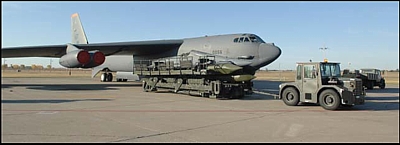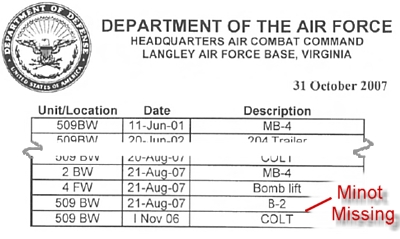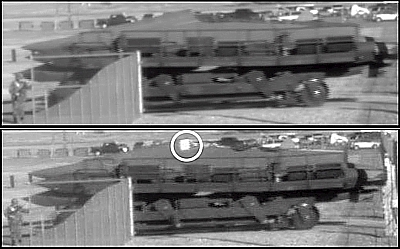Nuclear Safety and the Saga About the Missing Bent Spear

By Hans M. Kristensen
The recent Senate Armed Services Committee hearing on Air Force nuclear weapons safety was a welcome but long-overdue event. Internal reports about deteriorating nuclear weapon safety and surety in the Air Force have been accumulating since the early 1990s, but six nuclear weapons had to “disappear” for a day from Minot Air Force Base last August to get the Pentagon and Congress to finally pay attention. Had it not been for reporter Michael Hoffman at Military Times, the incident likely would have been filed away in secret cabinets as well.
Two internal investigations have identified numerous deficiencies in the handling and management of nuclear weapons within the military and have recommended substantial changes. Some of the obvious recommendations – such as not storing nuclear and conventional weapons in the same bunker and that personnel must follow the rules – have now been implemented. Others will require more effort.
Yet the investigations have revealed an inherent problem in post-Cold War nuclear planning: self-management and lack of independent oversight. Indeed, the investigations themselves appear to have been hampered by the same shortcomings. The result is an inherent conflict between scrutinizing and promoting the nuclear mission and a reluctance to change things too much.
As a consequence, the reviews recommend revitalizing the nuclear mission and returning the bombers to a heightened nuclear alert posture to improve safety, while missing the most obvious and effective fix: removing nuclear weapons from bomber bases and ending the operational nuclear bomber mission.
The Missing Bent Spear
When the Blue Ribbon Review was completed last October, Major General Richard Newton, the Assistant Deputy Chief Of Staff for Operations, Plans and Requirements, who headed the review, stated that the six-week investigation had “found that [the Minot incident] was an isolated incident.”
That was obviously good news, but the reason he could say that appears to be that the incident was never formally categorized.
In the news media the Minot incident was widely described as a Bent Spear incident, and an American Forces Press Service news article on the Defense Department web site refers to the event as a “’Bent Spear’ incident.”
But when I asked Air Combat Command (ACC) for a list of all Bent Spear and Dull Sword incidents since June 1992 when ACC took command of Air Force nuclear weapons, the list included plenty of Dull Sword incidents but not a single Bent Spear. Three months of phone calls and emails to the Air Force for an explanation for the omission have gone unanswered. While writing down my question and contact information, however, one officer volunteered off the record that “they” hadn’t given the Minot incident a formal designation because they didn’t quite know what to call it.
–
The Defense Department defines a Bent Spear as “a nuclear weapon significant incident involving a nuclear weapon or warhead, nuclear components, or vehicle when nuclear loaded.” The term includes a “significant incident,” which is defined as “An unexpected event involving nuclear weapons, nuclear components, or a nuclear weapon transport or launch vehicle when a nuclear weapon is mated, loaded, or on board, that does not fall into the nuclear weapon accident category but that:
- Results in evident damage to a nuclear weapon or nuclear component to the extent that major rework, complete replacement, or examination or recertification by the DoE is required.
- Requires immediate action in the interest of safety or nuclear weapons security.
- May result in adverse public reaction (national or international).
- Could lead to a nuclear weapon accident and warrants that senior national officials or agencies be informed or take action.
| Table 1: DOD Nuclear Weapons Accident/Incident Code Words |
|
| Code Word | Definition |
| Dull Sword | A nuclear weapon event or deficiency not categorized as an accident. |
| Bent Spear | A nuclear weapon significant incident [not categorized as Broken Arrow or NukeFlash] involving a nuclear weapon or warhead, nuclear components, or vehicle when nuclear loaded. |
| Broken Arrow | A US nuclear weapon accident that does not create the risk of a nuclear war. |
| Empty Quiver | The seizure, theft or loss of a US nuclear weapon. |
| NukeFlash |
Accidental or unauthorized launching of a nuclear weapon which could create the risk of war. |
One example of a previous Bent Spear incident is from January 19, 1966, when a Terrier anti-air missile with a nuclear warhead was dropped during handling operations onboard the guided missile destroyer USS Luce (DDG-38) while in Mayport, Florida. There were no personnel casualties, but the warhead was dent, requiring offloading and repair of the weapon.
The Minot incident as it is been described by the investigations certainly seems to fit the Bent Spear category, yet it’s missing from the ACC list, and no one has been able to explain why. Obviously, if important incidents are not on the official incident list, how can we learn from them in the future?
Instead, the list contains 237 Dull Sword incidents since 2001. The list is a printout from ACC’s Safety database, which was set up in 2005 as part of a mishap prevention effort. Before that, Dull Sword records were deleted once the problem was fixed, or two years after the initial report, the Air Force told Hoffman.
The Air Force Safety Automated System (AFSAS), which is a web-based system at Kirtland AFB for reporting and query about accidents and incidents, contained 78 Dull Sword investigations as of November 5, 2007, or 159 fewer than the ACC database. Of the Dull Swords in AFSAS, 56 had been completed since March 2007, with the remaining 22 still “in-work.” Like the ACC list, however, no Bent Spear is listed in 2007.
Nuclear Overconfidence
The Senate hearing and statements made by military officials to the media revealed a worrisome degree of overconfidence in the safety of nuclear weapons operations and regulations. Air Force Lieutenant General Daniel Darnell responded with an affirmative “yes, Sir. That’s correct,” when Sen. John Warner asserted that “the American public was never in danger as a consequence, if there’d been an accidental dropping or otherwise of these weapons.” “Good,” the Senator responded.
But this misses the larger picture, which is that it is an acknowledgment of inherent dangers to the public from flying nuclear weapons that has motivated the Air Force not to fly such weapons on combat aircraft for the past 40 years.
General Darnell told the Senators that several investigations had led to 132 nuclear-related safety recommendations, and that “as of the time of this hearing, nearly one quarter of the recommendations are complete.”
Even before that, the new base commander at Minot AFB, Colonel Joel Westa, told Associated Press that new and “more robust” nuclear weapon control policies were in place, and that he was ready to guarantee that no such breach of weapons handling will happen under his – or future – commands at the base.
Such nuclear overconfidence is problematic because it glosses over the hard-learned lesson that, no matter what level of security and proficiency, accidents have nasty tendencies to happen where they are the least expected. Before Minot, any Air Force official would have insisted that they had the world’s best nuclear safety standards. But people didn’t follow the rules. Some of the more egregious violations include unauthorized changing of inspection and bookkeeping procedures, failure to update tracking documents, and failure by numerous crews to perform required inspections.
–
The investigations clearly showed that the problem goes far beyond Minot to higher commands. The Blue Ribbon Review, which identified 36 observations that lead to 36 specific recommendations to correct the problems, also discovered that “Previous reports and studies during the past 15 years identified many of these observations and recommendations.” The Defense Science Board more pointedly observed that the Defense Department “has received authoritative and credible reports of declining focus and an eroding nuclear enterprise for at least a decade with little in the way of effective and lasting responses.”
I found many of those reports when I researched my 2005 report on nuclear weapons in Europe, but other than observing that the Cold War ended and attention to the nuclear mission consequently dwindled, the Minot investigations have largely failed to explain why the military has been so inept in responding to the numerous warnings that have accumulated over the past decade and a half. The base commander and the guys on the ground have been punished, but who is responsible “upstairs” and where is the accountability?
An Opportunity to Reinvigorate the Nuclear Mission
Several of the recommendations seek to, in the words of the Blue Ribbon Review, “reinvigorate” Air Force nuclear operations and “develop a long-range Force Development strategy to support the USAF enterprise.” The Defense Science Board report concludes that “there is little mystery regarding what needs to be done [to correct the problems] or how to do it. The nuclear enterprise performed at all levels with the needed competence for decades,” and the Board says its report is intended to summarize “what needs to be done to restore that performance across the board.”
No one can be against correcting deficiencies, but elements of the two reports give the impression that some also see the Minot incident as an opportunity to breathe new life into the Air Force’s fading nuclear mission. One of the most controversial recommendations is to increase nuclear bomber alert status and begin to practice full rapid nuclear response of the wings. The Blue Ribbon Review report language is vague – “Evaluate and enforce appropriate exercise guidance in regard to frequency and scale to ensure proficiency” – but the Defense Science Board puts it more bluntly by recommending that:
“the Air Force dedicate the full rapid response commitment to the nuclear mission on a continuous basis, rotating the commitment among the B-52 squadrons. During the commitment to the nuclear commitment, the unit would be [under operational control by] Task Force 204 (the Air Force nuclear bomber component to USSTRATCOM) and would focus on training for the nuclear deterrent mission.”
Moreover, the Board also recommends that nuclear operational readiness inspections be changed to “include comprehensive evaluations of all tasks required to generate the full rapid response nuclear bomber force commitment for the inspected unit and supporting activities outside the unit to include tanker support.”
–
That seems to me to be trying to turn back the clock. The United States stood down its bomber force from nuclear alert in 1991 because the Cold War was over, and has managed to deter other nuclear powers just fine since. The “decades” that the Defense Science Board compares today’s performance requirements with were the Cold War, which seems highly inappropriate to use as a standard today. Besides, increased alert and training will increase handling of nuclear weapons which will increase the risk that something goes wrong.
Rather than showing a requirement to return to Cold War-like alert operations, the poor performance may be a symptom of a nuclear mission that is out of sync with the real world.
Ironically, this is to some extend acknowledged by the Board’s report (although not acknowledged as such), which argues that significant reductions in the number of operationally deployed strategic warheads have not been accompanied by a proportional reduction in the number of remaining weapon systems. This has helped create a situation where the complexity of the nuclear enterprise is not matched by available resources, the Board concludes.
An independent investigation might have interpreted this situation as a reason to question the need to continue maintaining an operational nuclear bomber force. But not the Defense Science Board, which instead uses safety problems to argue for a revitalization of the Air Force nuclear mission. In fact, “the nuclear mission is, in some aspect, more complicated today” than during the Cold War, the Board concludes.
But that is a stretch. The nuclear mission is not more complicated today than during the Cold War, but far less complicated because nuclear weapons play a far less important role in today’s world and are likely to continue the downward trend in the future. What complicates things is that the nuclear guidance and posture have not been adequately scaled down to reflect that world, that planners have messed things up by calling for mixed nuclear and conventional capability-based planning under the New Triad, and that the Minot investigators try to reinvigorate the nuclear mission rather than thinking outside the box.
Implications and Conclusion
One of the most important implications of the Minot incident is that the widespread assumption that “loose nukes” is a phenomenon confined to failed and “rogue” states is wrong. Even in a stable and democratic country with intense security and command and control procedures, relatively adequate funding, and personnel job security and training, nuclear weapons can go missing.
Luckily, this time the six warheads were not stolen, but for more than a day the Air Force didn’t know that they were even missing. If they had been stolen, the nearly 36 hours that passed before the Air Force realized the weapons were missing would theoretically have given thieves plenty of time to bring the warheads into the center of Chicago or smuggle them out of the country.
Improving safety procedures, training programs and command structures is fine as long as it doesn’t lead to nuclear overconfidence. Before the Minot incident, the procedures were seen as sufficient and personnel highly skilled. After the incident and tightening up of procedures, things are said to be fine again. But it is important not to lose sight of the fact that no degree of safety is better than the people performing it.
But above and beyond safety issues, the most important implication seems to be that, absent a clear and present nuclear danger (and no, worst-case nuclear terrorism scenarios just don’t cut it!), the nuclear mission is no longer exciting or important enough to generate the vigilance that is required to maintain safe operational nuclear bomber forces. Sitting inside a weapon storage area on a bomber base and “believing” in the nuclear mission, while watching colleagues return from “exciting” real-world nonnuclear operations, can only be bad for nuclear moral. And for the Minot investigations to suggest that words from upstairs, a new round of reorganization, and increasing the nuclear alert posture can somehow rekindle the nuclear quest seems like a fallacy.
The Blue Ribbon Panel and Defense Science Board have misread the Minot incident by failing to take into consideration the realities of the post-Cold War world. Instead of recommending a revitalization of the nuclear bomber force, their main conclusion should have been that there no longer is a need for an operational nuclear bomber mission and that nuclear weapons should be removed from the bomber bases.
Additional information: Blue Ribbon Review | Defense Science Board Report | Flying Nuclear Bombs | Air Combat Command Dull Sword and Bent Spear Incident List, as of October 31, 2007
The FY2026 National Defense Authorization Act (NDAA) paints a picture of a Congress that is working to both protect and accelerate nuclear modernization programs while simultaneously lacking trust in the Pentagon and the Department of Energy to execute them.
While advanced Chinese language proficiency and cultural familiarity remain irreplaceable skills, they are neither necessary nor sufficient for successful open-source analysis on China’s nuclear forces.
Satellite imagery has long served as a tool for observing on-the-ground activity worldwide, and offers especially valuable insights into the operation, development, and physical features related to nuclear technology.
This report outlines a framework relying on “Cooperative Technical Means” for effective arms control verification based on remote sensing, avoiding on-site inspections but maintaining a level of transparency that allows for immediate detection of changes in nuclear posture or a significant build-up above agreed limits.


